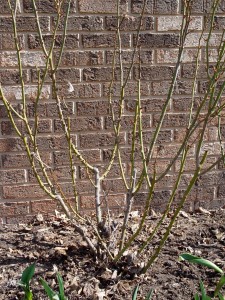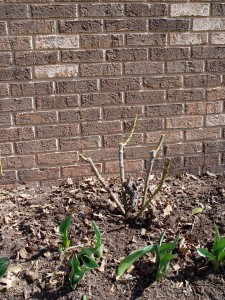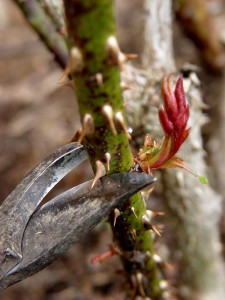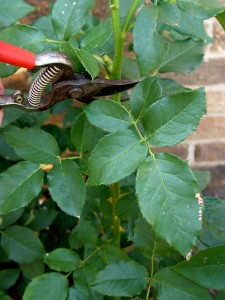The Mystery of Rose Pruning
April 6th, 2006
Few gardening deeds generate more contention and hesitation than pruning roses.
Do you prune them in one fell swoop in spring or should you be going with a fall-and-spring two-step?
How much do you take off?
Which canes go and which should stay?
And, of course, the biggie: To seal or not to seal those cuts?
Everyone has his or her own system, especially when it comes to the widely planted hybrid tea, grandiflora and floribunda types.
Even the experts don’t agree on how best to prune.
Take Steve Hutton, for instance. He’s the president of West Grove-based Conard-Pyle Co., growers of the popular Star Roses, and an avowed two-step man – sometimes.
“I’m a fan of pruning about a third of the plant back in the fall,” says Hutton. “The main point – in fact, just about the only point – is to remove the whippy growth of fall that could be susceptible to damage in an ice storm.”
If you don’t think that’s going to happen, never mind. Wait until spring.
Come early spring, Hutton suggests removing dead canes and canes skinnier than a pencil. Cut those right to the ground.
The rest should be cut back to live wood, he says, “even if it means cutting back virtually to the bud union (where the rose has been grafted to hardy root wood). Otherwise, cut back to 12 to 18 inches.”
Live wood has a green color. Dead wood is black. Or you can simply wait for the buds to swell to see which wood is alive and which isn’t.
Hutton uses the NCAA basketball finals (typically in late March) as his cue to get busy, and aims to be done by April 15.
“If your team isn’t in the finals,” he says, “you can prune anytime at all. If it is, the best time to prune is between games.”
At the Dumbarton Oaks public garden in Washington’s Georgetown section, Director Gail Griffin uses a two-step system – except step one is in January rather than fall.
“We like our roses to be dormant,” she says, “We want them to recognize it’s winter before we do anything.”
In January, Dumbarton’s 1,000 rose bushes have their taller canes clipped back to about waist high. At the same time, seasoned manure is mounded over the grafts, and any remaining leaves are stripped and removed to prevent black spot – the disease bane of most roses.
Griffin says this winter pruning eliminates snapping-off injuries but also spreads out some of the pruning work.
Come late March, the Dumbarton crew thins out each bush to three or four healthy canes, each about the size of a finger.
These canes are then shortened to about knee high (12 to 18 inches) and cut at a slight downward angle about one-eighth of an inch above the bud. The angled cut encourages rain to run down and off the cut, while the one-eighth inch above the bud prevents bud injury while avoiding longer dead stubs.
“We try to cut just above buds that are facing outward,” Griffin says. “That opens up the interior of the plant.”
Buds that are facing outward will grow branches in that direction. The goal is to give plants a uniform vase shape instead of ending up with a criss-crossing mess of inward-facing branches.
Stephen Scanniello, a 1978 Lebanon Valley College graduate who went on to become curator of the Brooklyn Botanic Garden’s Cranford Rose Garden, doesn’t believe in “steps” at all. He considers rose-pruning to be a continuous job.
“It should start in spring and go to Labor Day,” says Scanniello, who has written four books on roses. “Pruning shouldn’t begin and end in spring.”
Now a garden consultant and frequent rose lecturer living in Barnegat, N.J., Scanniello usually starts pruning around St. Patrick’s Day – sometimes even toward the end of February.
“The initial spring pruning should be to eliminate much of the clutter,” he says. “I usually leave behind about one-third of the bush, which is about three to five canes.”
The rest get cut to the ground.
Scanniello cuts the keepers a little lower than most, going down six to 12 inches for hybrid teas and about a foot for grandifloras, floribundas and English types. He cuts about one-quarter of an inch above outward-facing buds.
If you keep pruning throughout summer, says Scanniello, you won’t end up with tall, whippy growth in fall that could tear off over winter. He says most people aren’t nearly “ruthless” enough with summer pruning, which not only keeps plants looking neater but encourages more and bigger flowers.
“I’ve gone through my garden in late July and pruned almost as severely as in March,” he says. “You get great blooms in September.”
All three experts advocate the in-season cutting of canes down to at least the first cluster of five leaflets. Growth at the cane tips tends to have clusters of only three leaves.
Scanniello even removes whole canes to the ground in summer if a plant is getting too dense. Then after Labor Day, he knocks off pruning so as not to encourage new growth that’ll be particularly susceptible to winter-kill.
“You’re bound to get some winter-kill into early spring,” Scanniello says. “That’s why I’d rather prune then – to take care of that and do the shaping at the same time.”
As for sealing pruning cuts, none of these three experts believes it’s necessary.
“In our test fields,” says Conard-Pyle’s Hutton, “we have thousands of plants to cut back every year. We use a flail chopper, which is a nasty piece of farm machinery used to cut and chop field silage. The result is ugly, but it’s quick and works just fine… and we’ve never lost a plant due to not having sealed the cuts.”
Scanniello says there’s only one good reason to seal a pruning cut – if you’ve had problems with sawfly larvae, which tunnel into canes. “White wood glue works as well as anything,” he says.
Griffin says Dumbarton Oaks has had that pest, and so each rose-pruning staffer is equipped with a bottle of Elmer’s glue.
“We haven’t had any borers since,” she says.











